{Guest Post by Ted Slagle}
Whether you are looking to learn to climbing because of your love for the mountains, you just got inspired after your first time watching Free Solo, your preferred way of socialization is by turning to face a wall, or your friends took you bouldering at the local gym… you had a taste and you want more.
Well look no further, because I have the ultimate guide to rock climbing for you.
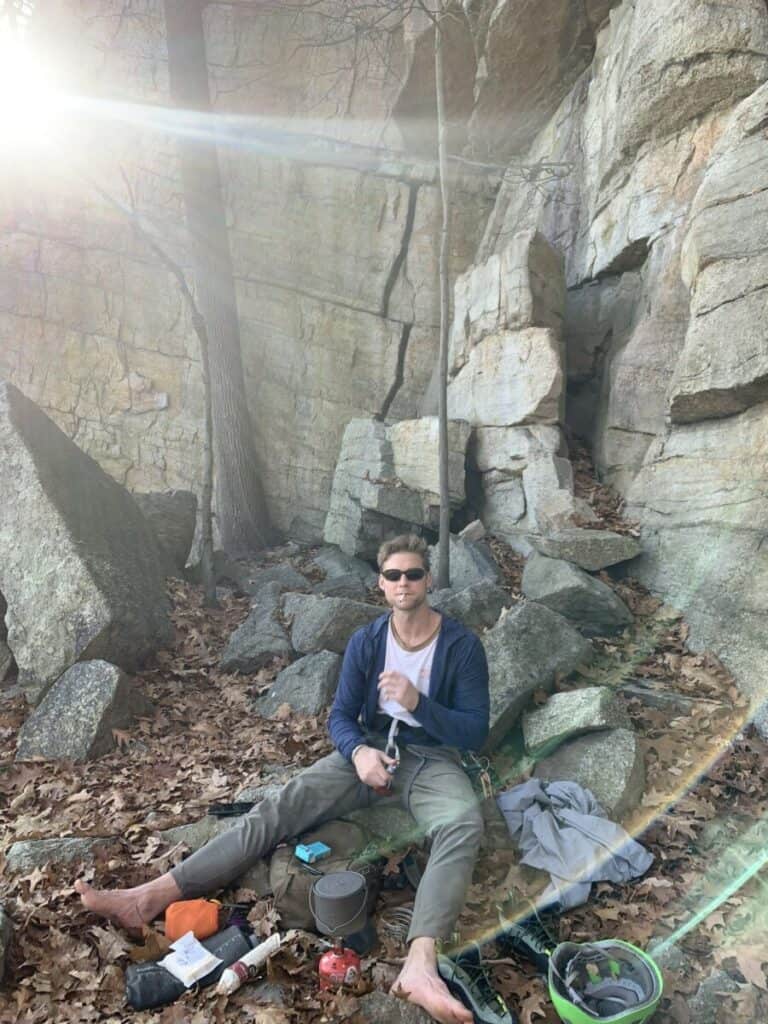
Read it all, skip to the sections you want, or chew on it for a while; this is meant to be a reference for your curiosity.
You’ll learn the history of rock climbing, how to train as a beginner, the mental side of the sport, climbing etiquette and lingo, grading systems, and a bunch of other useful stuff I wish I’d known when I was a gumby.
How I Got into Rock Climbing
My name is Ted Slagle, and my climbing origins stem from a particularly humbling and adventurous trip in the Adirondack mountains with my dog, Maverick.
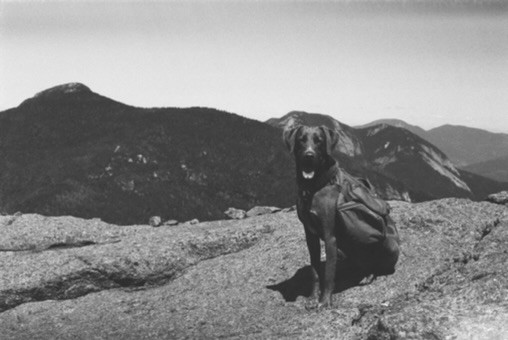
We backpacked for 3 nights in the High Peaks of New York, and had some of the more serious mountains in the park listed on our attack plan.
After brewing some Tea on top of the indomitable Mount Marcy, the highest peak in New York, and ticking Mount Haystack, which could only be described as looking like “The Thing” in the Fantastic 4, we pitched camp in the neighboring col for the night and mentally prepared for Basin and Saddleback mountain.

Saddleback is known as more of a climb than a hike, and on this mountain the lines are certainly blurred. The terrain became more vertical, requiring use of my hands and feet to pull myself up. After gaining ledges where safety briefly resided, I would pull up Maverick, and continue on while he waited stoically.
It was all a little more exciting than I had anticipated, and upon reflection, and admittedly watching Free Solo, I decided that it was a little too sketchy of an experience.
If I wanted to keep hard core adventuring, and do so safely, I needed to learn to use rope systems. Technical rock climbing was the natural next evolution for me, and I was stoked.
Coincidentally, this was the same progression that developed modern rock climbing. Climbing wasn’t seen as its own discipline back in the early 1900’s, and was viewed as an extension of hiking. But as ascents became increasingly difficult, they required new forms of gear, technique, and overall style.
A Brief History of Modern Rock Climbing
The film Valley Uprising (highly recommend watching if you want to learn more on the origins of climbing culture and ethics) highlights the key events that revolutionized the nature of climbing. In the US, it all started during the ’Golden Age’ of Yosemite (1950’s-1970), and the ‘Stone Masters’ era (1970-80).
Essentially a group of counter-culture renegade dirtbags living out of their tents in Camp 4 at Yosemite National Park, subsisting on canned tuna, dumpster diving, copious amounts of marajuana, and high adventure, dared to quest into of the most impregnable cliffs known to man.
Here is a wonderful article that goes more into the lifestyle and philosophy these Golden Age climbers subscribed to.
Yvon Chouinard, the founder of the highly successful clothing company, Patagonia, and Golden Era climber, was a self-taught blacksmith and forged climbing equipment to afford his dirtbag lifestyle.
The Golden Age of Rock Climbing
The Golden Age climbers relied on driving nails, or pitons, into the natural cracks of the rock.
They would use these pitons as fixed points for gear to climb like a ladder. There was a focus on “clean-climbing ethics”, or using as limited means necessary to ascend a route.
The Golden Age climbers were extremely romantic about their discipline, and compared the nature of their pursuit to that of an inspired artist. Royal Robbins, one of the most legendary figures of his time, called climbing “an act of brilliant creativity”.

However, true clean climbing wasn’t fully realized until the next generation, the Stone Masters, took their climbing skills to the next level and climbing technology improved.
They strengthened their climbing skills, developed their athleticism and utilized the natural features of the rock to climb using their hands and feet. The pitons and new forms of climbing devices that engaged the cracks were used as a means of protection from falling rather than ascension
The Golden Era and Stone Master climbers lived a subsistence lifestyle, and took seriously the literature and existential pontification of their time.
Jack Kerouac’s novel “Dharma Bums”, published in 1958, perfectly encapsulates their sublimity.

In my opinion, these iconoclastic athlete-hobos epitomized the philosophical idealism of the Beatnik Revolution and hippy movement of the 60’s and 70’s.
The Birth of Modern Rock Climbing
This was the birth of modern rock climbing. Gear, style, ethics, and certainly climbing gyms, may have evolved, but climbing owes its constitution to its ishmaelite beginnings.
What has remained the same is far greater than what has changed: challenging yourself against the depths of the unknown in style. People are out there, still pushing new frontiers, defying the limits of human possibility through imagination, creativity, and grit.
Now onto the guide.
How to Teach Yourself Rock Climbing Basics
I have written what I believe is a comprehensive guide on what you should know as a beginner if you are stoked on the sport.
All of the information has been hard won knowledge extracted from peers, partners, doctors, books, and movies, so read the whole thing from start to finish, or take only what you want or need. The rest will always be hanging here as a reference.

I think the only natural place to start for the avid readers of knowledgelust.com would be how climbing is beneficial for developing your mental faculties, but don’t take my word for it!
Learn the Mental Side of Rock Climbing
If you choose, climbing can be much more than an exercise or de-stressor after work. Climbing has great restorative value, but if you subscribe to the ethos of this blog, I’m guessing it’s because you are here to expand and sharpen your mind and you want to take this a step deeper.
I am a big believer in the concept of skill transference. There is a particular set of skills that can be applied from discipline to discipline.
When you practice many arts and abilities, you are able to dissolve the boundaries that differentiate them, and see the common principles that unite them. All disciplines are a vehicle for sharpening the acuity of the mind, increasing awareness and knowledge, and deepening your intuitive thinking.
Changing your mind
Climbing is a valuable tool for gaining almost psionic mental power useful in all aspects of our life from our career to our relationships.
The human mind has a profound ability to change the composition of its psychological experience. Throughout history, cultures all over the world have experimented with mind altering substances and practices with the goal of extracting knowledge and understanding the substance of their mind.
There are many ways to do this through activities such as fasting, sauna, gratitude, and meditation to name a few. Heck I even drank coffee and smoked cigarettes late at night to help me squeeze in a couple extra hours of studying during graduate school.
In my opinion many of these methods offer a verisimilitude experience and are of little practical value.
The climbing experience, however, engages you directly with reality without external influence, and is unmatched in its effectiveness for analyzing your unconscious processes and changing the quality of your mind.
So how does climbing change our conscious experience, and what can we learn from it?
Let’s perform a thought experiment… stand up on your two feet, and look down. No problem, right?
Now imagine standing 1,200 feet in the air at the edge of the Empire State Building, looking down and seeing the now ant-sized citizens of New York City scuttling along the sidewalk. I bet you aren’t as confident in your ability to stand steady now.
So what is the difference?
Fear pushes us out of our comfort zone. It makes us irrational and doubt abilities that are well within our capability. This is where the magic and value of climbing consciousness is found: the separation that fear creates in us from our unperturbed mind.
The pragmatism of this experience is in the tools we create to be mentally powerful and act effectively in the face of danger.
So many of our habits in day to day life have developed from reactions to fear – triple checking your alarm before bed – going back home to double check that you turned the stove off… just to name a few. These are small examples of a larger problem: we do not have impeccable use of our attention and awareness in our daily lives.
Climbing is a great arena for creating more personal power that allows you to grow past fear driven patterns. Integrated into your life, you can utilize these abilities to operate effectively in the midst of adversity.
The mind body illusion
The western understanding of consciousness identifies the mind as the locus of control for our body. This commonly dubbed, “mind-body experience”, a platitude of western yogic principles, teaches us that there is a semi-permeable border between the mind and body in which a back-and-forth dialogue is occurring.
I believe the presence of a conversation between the mind and body is an illusory experience produced by the ego.
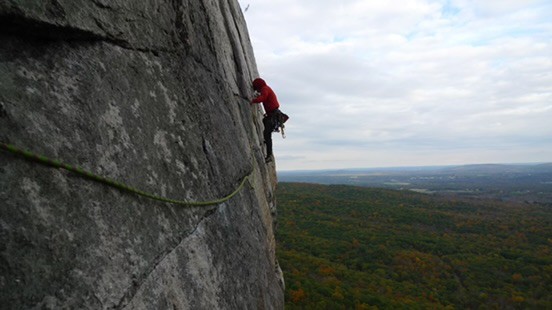
This “conversation” quickly comes to an end when you push yourself past your comfort zone and harness the power of fear to heighten your senses, quiet your mind, and act on instinct.
This is popularly known as “the zone” in sports, or a “flow state”. The intelligence that resides in your body and not in your rational thinking mind is better able to express itself in this state.
Fear helps us take a step past our ego, and engage an older and deeper source of knowledge within our mind.
But don’t worry, once you’re done climbing your ego will slither its way back into the forefront of your mind, in an effort, as it always does, to praise your achievements, or to coddle you from failure. Meant as a means of self preservation, your ego seeks to shelter you from change, and compares you to others based on achievement, lowering your self esteem.
Climbing consciousness provides an arena for you to challenge the self-limiting beliefs that your ego-mind will tell you. The book The Rock Warrior’s Way is one of the best guides to practical psychology and applying eastern philosophy in a zen approach – or one that will improve our daily lives.
I have read the classics of eastern literature, and some of the esoteric, and this unassuming book on rock climbing stands its ground against the wisdom of any ancient text I have come across.
It teaches you methods for dealing with your ego when it rears its ugly head by offering tools to challenge its capacity for self-limitation to empower your actions and growth.
I view climbing as a way of amplifying your attention to your consciousness, making it more malleable than in your daily mind-state. You are actively utilizing the larger mental faculties of your mind and doing mental pull-ups.
Now that we have gone over how climbing keeps your mind strong and healthy, let’s go over how to keep your body strong and healthy while you’re learning to climb.
If you want to learn more about eastern philosophy, check out this self-education roadmap for Buddhist philosophy.
How to Train for Climbing as a Beginner (Tips & Methods)
There have been books, youtube channels, blogs, and careers dedicated to this subject. It can be dizzying to sift through it all. I am going to share what I believe to be absolutely essential for a beginner to stay healthy and get stronger.
When you begin a new physical activity, whether it’s kickboxing, climbing, or pitching, your body will adapt to the new strain.
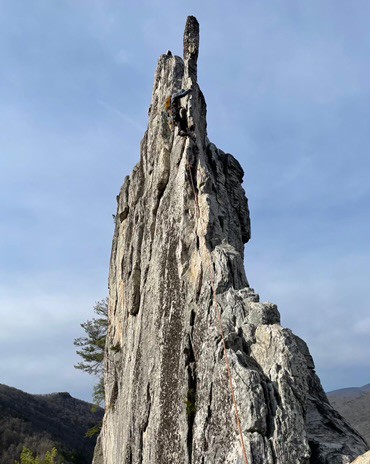
As new points of stress arise in your body, your tissues will reorganize to compensate.
Your muscles will quickly get stronger, but this isn’t the only structure that sees changes; your bones, as well as your tendons and ligaments will also remodel.
It takes around 1-2 years for your bone to turn itself over completely, and years of training for your tendons and ligaments (which I will refer to as dense connective tissue) to adapt to the demands of your new discipline.
This leads me to my first and most important point and warning for training as a beginner: as you learn climbing movements, and your muscles quickly get stronger, your dense connective tissue lags behind. While your muscles may have compensated for the strain, your tendons and ligaments have not.
This can lead to dense connective tissue injuries like tendonitis that can be chronic and debilitating.
What Training for a Marathon Taught me About Training for Rock Climbing
Before I got into climbing four years ago, I spent 2.5 years training year round for marathons.
After my second full year of marathon training and second marathon, I felt I had a well of unrealized potential yet untapped. I had achieved a personal record of 3 hours and 17 minutes with very little discipline or training knowledge, and decided to step up my preparation for next year and set a goal of breaking the 3 hour mark.
So I began by getting to work on a smaller and comparable goal of running a 1:25 half marathon. I found a professional training plan from Runner’s World magazine on how to run a sub 1:25 half, and followed it to a T.
I learned valuable lessons in the process of training to be an advanced marathoner. Unfortunately for my marathon goals, my half got postponed the afternoon before race day because of covid, and races were canceled for the foreseeable future. Fortunately for my climbing career, I got a dog, and took up trail running and backpacking with him, which led to my interest in climbing.
While distance running and climbing are inherently different sports and motions, the rationale behind the way you train to get stronger and stay healthy is derived from common principles.
Generally the program consisted of 4 days of long slow running, and 2 days focused on speed. At the very peak of training intensity, only 46% of the mileage was run for speed and above lactic acid threshold (this is an important concept to understand for climbing too.)
Lactic acid is a byproduct of physical exertion that causes muscle fatigue and failure. This is the “pumped” feeling in your forearms when you are climbing. At lower levels of activity, your body can clear the lactic acid. Your lactic acid threshold is the point of exertion where your body is no longer able to clear lactic acid faster than it is accumulated.
Lactate threshold: What is it and how can you determine yours?
I think that for a beginner climber, it’s probably better to climb below your lactic acid threshold at a grade that feels easy for 2/3 of your training days; around 1/3 of training should be dedicated to maximum effort climbs. During your below threshold climbing you can focus on drills that will help you move better and with more technique along the rock.
When I first started climbing, I studied the book The Self Coached Climber by Douglas Hunter. It went over essential principles and drills for movement and balance that can be practiced during below threshold climbing.
Plenty of drills for climbing technique can also be found on blogs and youtube like these two I have added (I prefer books for learning skills because they tend to be comprehensive guides written by individuals with expert knowledge).
3 KILLER DRILLS I Use for Flagging
Aerobic Restoration and Capillary training
Aerobic Restoration and Capillary training (ARCing for short) is probably the best exercise I should’ve done as a beginner that applies all of the principles of tissue adaptation I have been expounding on. ARCing is essentially a long slow run, and is the best way to protect and strengthen your tendons and ligaments while still feeling like you are challenging yourself.
The goal of ARCing is to climb up to 20-30 minutes continuously without passing your lactic acid threshold threshold and getting too pumped to climb. What will inevitably happen in the beginning is you will most certainly get too pumped before the 20 minute mark, but you will learn valuable lessons on finding resting positions, climbing efficiently, and climbing movement. You can break this up into smaller chunks of time totalling up to 20-30 minutes overall until you can complete the drill in one push.
Once you reach 20 minutes you can progress to mixing in some smaller hand holds. ARCing is also a great time to practice your climbing movement drills if you are up for it. I also recommend standing on smaller footholds as this takes no extra physical effort and will improve your comfort on small feet down the road.
My gym has a circuit board trainer, where there are different holds scattered. I don’t follow the path of the circuits, I just climb on any hold that is appropriate for my goal of intensity that particular day.
You can also ARC on your bouldering wall, just be respectful of those climbing around you, don’t hog routes, communicate, and try to climb at less busy hours and sections of the wall. Your local bouldering wall should have enough large holds for you to find an easy way across, although this may come as a challenge. It’s no problem if you fall off because of a tricky section, just get back up and keep moving.
Because your muscles are working at below their maximum strength, your tendons and ligaments gain most of the adaptation and are the focus of this type of training. This is great for your health as a climber, and will ultimately result in you being able to climb harder in the future.
4x4s
4×4’s are another great drill for all levels of climbers for high intensity days that dont consist of you climbing at your peak. Pick four bouldering (or roped) routes that you are challenging but you are able to repeat consistently. Typically this falls 1-3 V grades below your maximum ability. Do all four problems in a row without a break. Then rest for 4 minutes and repeat this four times.
4×4’s are a fantastic way to train power endurance, while still remaining below peak stress.
Hangboards
Hangboards are also a fantastic way for climbers to strengthen their fingers. It is generally recommended for beginners after around 6-12 months of consistent climbing. Focusing on high volume and low intensity while beginning to hangboard is essential for preventing injury.
7x3s
7×3’s are the best way to do this. First, find the biggest edge on a hangboard that you can comfortably hang on. Then download an interval timer. I use the app Tabata Timer. Hang on the edge for 7 seconds, rest for 3 seconds, and do this 6 times. Take 4 minutes rest between sets, and do this again up to 6 times. If you can’t complete all 6 sets, go until your form breaks down.
Good form consists of an open-handed grip, shoulder blades pulled back, with engagement through the arms, shoulders, and back. You should not be hanging off the tips of your fingers while your body is completely slacked.
Never hangboard with your thumb locked over your fingers in a full crimp.
Max Hang
Max hang training is a great addition to your hangboarding regime once you have beefed up your tendons and ligaments after around 2 years of consistent climbing. When doing this drill, hang with an open hand grip on a 20mm edge for 10 seconds with the maximum weight you can hold with good form. Repeat this 6 times with 4 minutes rest between each rep.
Whenever you are doing a hangboarding exercise you should make sure you are properly warmed up. This goes for climbing in general too.
Warming up
Warming up is the most valuable tool you have for preventing injury. The muscles and dense connective tissue in areas under high amounts of stress, like the fingers, forearms, shoulders, and back, need to be prepared to bear heavy loads..
I do all of my warmups with light weight to a moderate fatigue.
First I use a light band to do Y’s, T’s, and W’s making sure my shoulder blades are fully engaged and pinched throughout the entire movement.
Next, to warm up my fingers. I put a band on the end of a Tension Climbing block and do curls with my fingers on the 20mm edge.
You also load and unload your fingers on any edge available to get the same effect. I used to gently fall back and catch myself with my fingertips on a steel support beam in my gym. You can also use a hangboard to partially load your fingers repeatedly.
Tendon glides are another great way for your fingers to prepare for loads, and I typically do these when my fingers feel stiff.
Lastly I make sure to do some forearm curls and extensions to get the bigger pulling muscles primed.
I then begin climbing on the lowest grade on big holds with a focus on smooth and technical movement. I work up progressively through the grades, and only when my body feels comfortable with the amount of force required do I proceed to the following grade. I may skip a grade if I am feeling warm.
You are increasing your risk of injury by immediately getting on a climb that is at or near your limit.
All this information being said, injury is a part of any sport, but you want to get ahead of the injury by training smart to speed up recovery. You can also learn a lot about where your physical weaknesses lay through injury. If you use it as a growing process, you can come away from the experience stronger and with more body awareness than before.
Listen to your body, stop when it hurts, and if you have an injury that just won’t go away, go see a physical therapist and/or a sports acupuncturist about it.
Too many climbers, including myself, are too proud and try to push through minor injuries that can cause some long lasting damage that lingers for years.
Remember my marathon training analogy, do not try to peak every session. You have to create peaks and valleys in your training; if you are only training peaks, the valleys will be decided for you with injury.
Climbing Etiquette
It is important to understand and follow the unspoken rules when around other climbers, many of which exist to respect their process and safety.
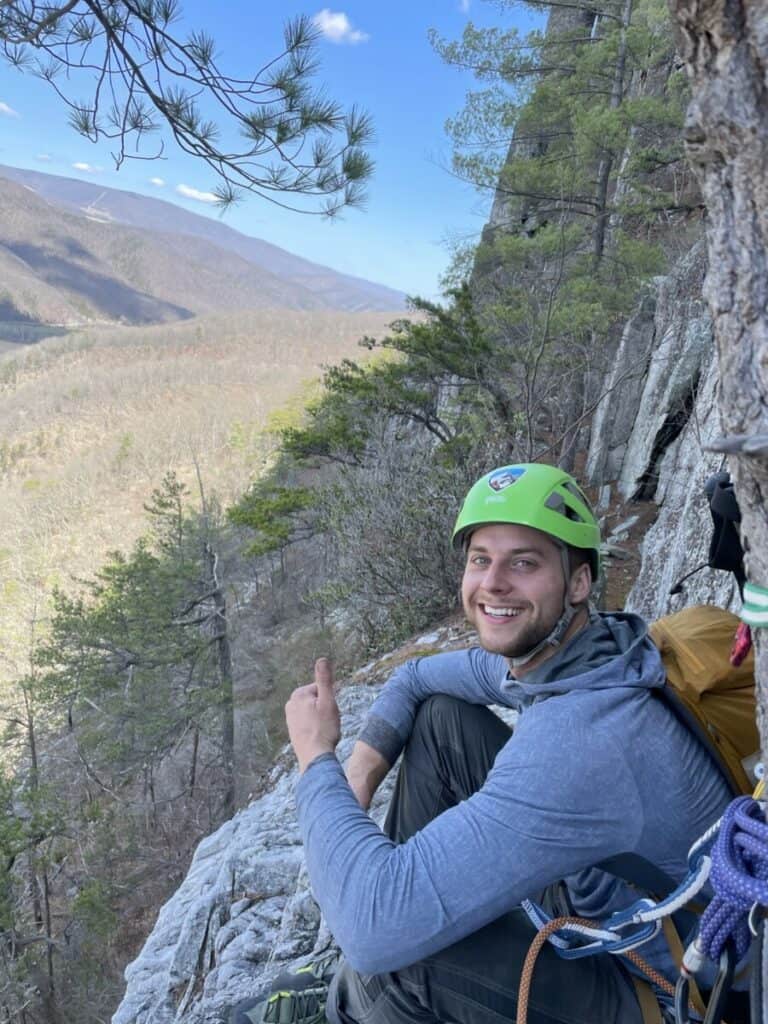
Here are a few that I think are important to practice…
- Stay out of the fall zone in the boulder and sport climbing areas. If someone falls on you it’s your fault. Don’t camp out underneath the wall to inspect a route.
- Wait until someone is done climbing if your intended route overlaps with their line.
- Don’t be afraid to be assertive but friendly to get into the rotation for a route. I typically stand and chalk up my hands to establish my intent to climb a route amidst wall traffic. Climbers are super nice, just communicate with others wanting to climb the same area and be courteous.
- Don’t offer someone advice on a climb unless they ask for it or you’re working out a problem together. It is okay to seek advice for yourself. Especially don’t yell out advice while someone is actively climbing. This is called beta spraying and it’s a no no.
- If you see someone brushing a route, let them climb it next. If you brush, you crush.
- When you are climbing outside, don’t belay off the anchors. Create your own anchor. If you don’t know how, you shouldnt be climbing outside without an experienced partner.
- Keep the stoke high! Cheer people on and encourage others.
- If you bring your dog to the gym or crag, make sure they are socialized, and highly disciplined. Crag dogs are somewhat taboo, and some people are extremely anti. If your dog can’t sit still unattended at a fancy restaurant, they shouldn’t be with you at the crag with you.
Now that you know how to behave, let’s go over how to speak about climbing.
Learn the Climbing Lingo
Climbers have their own dialect.
Gumby, beta, jug, Gaston??? You mean the guy from Beauty and the Beast?
It is important to learn some of the basics so that you can properly communicate well with primates at your local crag. I’ll cover some of the basics you’re likely to run into.
Gumby: someone new to climbing, and who makes beginner mistakes; used in a derogatory or self deprecating sort of way. Synonyms: kook; newb
Beta: the sequence of moves in a climb
Beta sprayer: someone who shares unsolicited beta
Project: a climb that takes multiple sessions to complete
Free climbing: a style of climbing where climbing equipment can only be used for protection, and not a means of ascension. Only your body and the rock are utilized for movement.
Free soloing: climbing without a rope
Send: climbing a route from start to finish without falling
Belayer: the person who manages the slack in the rope for the climber
Grigri: a belay device that auto-locks when a climber falls
Crux: toughest sequence of moves in a climb
Crag: a climbing area or a cliffside
Jug: larger hold you can grab with your whole hand
Crimp: small hold that you can only hold with your fingers
Undercling: a downward facing hold
Pinch: a hold you can squeeze on both sides
Pocket: a hole that can fit 1-3 fingers into
Positive hold: a hold you can sink your fingers into; jugs and crimps are positive
Volume: a large, typically pyramidal hold
Sloper: a hold with a negative edge and is sloped downward.
Side pull: a vertical facing hold
Gaston: when you hold a vertical hold with your thumb facing down
Jam: to wedge a part of your body into a crack to ascend while crack climbing. Most common are hand, finger, fist, and foot.
Smear: Footwork technique that utilizes the friction created by pressing the sole of the foot onto a flat surface to stand on
Match: putting two hands or feet on the same hold
Lock-off: when a hold is held with your arm deeply bent so you can reach the next hold
Static: doing a move slow and controlled without momentum driving the movement
Dyno: a move that requires you to jump from a hold to another; short for dynamic
Deadpoint: essentially a more controlled dynamic move. When you use momentum to throw your hand to a hold without cutting hands or feet
Campus: climbing on holds like rungs on a ladder without your feet on the wall
Flagging: to point a leg out to position your body better for balance
Flash: successfully completing a climb on your first attempt utilizing beta and prior knowledge
On-site: successfully completing a route on your first attempt without utilizing beta, touching the route, or prior knowledge
Redpoint: to successfully send a project after multiple attempts
Pitch: a climb that can be spanned using a single rope
Multi-pitch: a climb longer than a length of rope
Lead(er): during multi-pitch climbing, the climber that goes up first with the slack being managed behind them
Follow(er): during multi-pitch climb the leader has completed the pitch first and has set up a top rope from above for the follower to climb
The sharp-end: the end of the rope the lead climber ties into
Whipper: a long fall
Run out: when there is a long distance between you and your last piece of protection while trad or sport climbing. The slack is “run out”
Deck: when you hit the ground on a fall
Different Styles of Climbing
Bouldering
Bouldering can be a great introduction to climbing for the novice: it is accessible without a partner; minimal gear and technical knowledge keeps the barrier of entry low; and it has a puzzle-like nature that is mentally stimulating for people of all skill levels.
Boulder “problems” are short routes, typically a max of around 15 or so moves. Before bouldering became its own discipline, it was used to practice hard moves and develop skill for larger, more technical ascents in the mountains.
You can think of a boulder problem as the most difficult section of a roped climb, or “the crux”. It takes time to think through the movement on boulder problems at your limit. This will improve body awareness, route reading ability, and overall skill.
You can improve your climbing difficulty quickly by focusing on this discipline. Alternatively, it tends to be the most physically demanding, and lends to injury if overdone. For a beginner, think of bouldering at your maximum ability as a track workout for as a runner. Unless you’re training to be a sprinter, you shouldn’t spend all your time doing it. It is a great form of climbing that helps move your overall ability forward.
Top Roping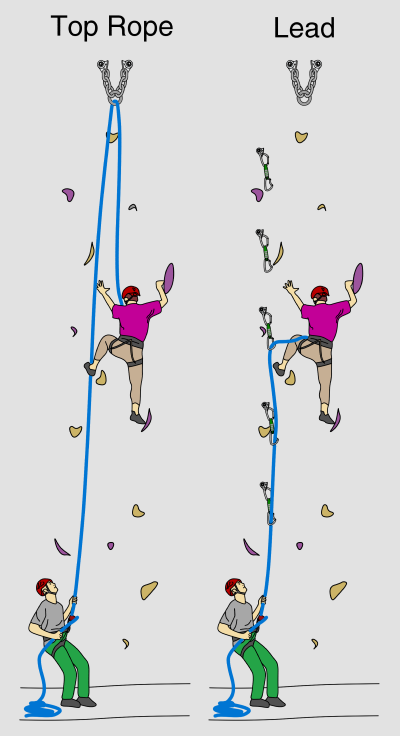
This is the way (most) beginner climbers are introduced to roped climbing. Whether indoors or outside, top rope is generally the safest and easiest way to climb a full route. It involves a fixed anchor at the top of the route and a belay partner controlling the slack.
Assuming your belayer is controlling slack properly, you should be arrested where you are in the case of a fall.
Top rope is a good way to get into a flow of climbing, increase your stamina, and project routes at the limit of your sport climbing ability.
Sport/lead climbing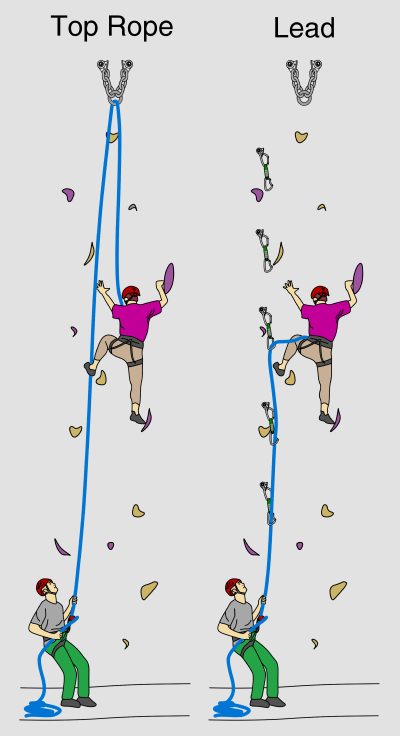
Where climbing with ropes gets a little more spicy. Instead of having an anchor at the top that you are fixed to, the climber will clip into fixed double-carabiners, or “QuickDraws” connected to a bolt in the wall. The belayer manages the slack from the ground up.
The climber progressively clips into the quick-draws as they ascend, until they get to the anchor at the top. If a climber falls before the anchor, they travel the distance they are above their last clip, the amount of slack in the system, and the amount of stretch in the rope combined.
Sport climbing was the first time the impeccability of my attention and intention were challenged during climbing. Adding the idea of consequence and fear to your climb is a paradigm shift.
It is a thrilling experience, and recommended to begin in a gym when you are comfortably completely climbed at the 5.10 grade in the gym.
Trad Climbing
In my opinion, the Mac daddy of climbing styles. Trad climbing has its origins firmly grounded in the ethics of the Golden Age and Stone Masters.
You use the natural cracks and weaknesses in the rocks to place camming devices, nuts, and other gear to protect you from your fall. If you’re curious about the form and function of these devices you can explore that here:
Trad climbing is as much about climbing as it is about understanding the mechanics of your protection, gear, and ropes system. It is monotonous, ritualistic, inherently more dangerous, but allows you to climb into austere cliff-sides with nothing but what you bring with you. Trad is steeped in self-reliance and adventure.
The most important piece of gear in trad climbing though, is your partner. Trad climbing requires an extreme level of trust in your partner, communication, and knowledge of each other’s strengths and weaknesses.
The relationships I have built with my trad partners has been one of the most rewarding aspects of my climbing, and a large part of the reason why I step into the gym each day to train. I don’t just train for myself, but to be a better climbing partner, and someone who can be relied on.
Free Soloing
Not to be confused with Free Climbing.
Free soloing is free climbing without a rope. Popularly viewed by society as suicidal and done only by people who have nothing to live for, the idealism of free soloists would probably argue that purity of the discipline is rooted in the risk of death.
Free soloing demands perfection of your physical movement and your mind. Many that free solo experience an even more elevated awareness than free climbing itself because of the heightened consequence. Personally the normal inherent risk of climbing is enough for me to strive to be perfect, but to each their own.
Some people also just like free soloing short and easy routes well below their ability as a way to move freely, or to train a “no-fall” mindset for critical situations while trad, sport, or boulder climbing where a fall risks injury.
I am by no means condoning this dark art as a way of training your mind, because it can put life at stake.
Deep Water Soloing (DWS)
The newest form of climbing, one of the least accessible, but one of the most sublime. Deep water soloing is climbing on cliffs above bodies of water. Essentially “safe” free soloing. Pioneered and popularized on the world stage by legend and my personal climbing hero, Chris Sharma, Deep Water is arguably the most pure form of climbing out there. You can watch Chris at work in Mallorca DWS here.
My only experience with DWS was above a waterfall in Vermont with a deep pool of water below to catch me. It was a far cry from the Mecca of DWS in Mallorca.
Falling without a rope was scary the first time because it felt different than any fall I’d ever taken. For the first time since I started climbing and learned to trust rope systems, I had a fear of heights. Unfortunately, after feeling more comfortable after my second attempt I lost my shoe to the dark watery abyss when I tossed it near the edge of the cliff and it took a bad bounce. Lessons learned.
In my opinion, the beauty, playfulness, freedom, and scarcity of DWS makes it the most alluring and imaginative style of climbing out there.
Become Familiar with the Grading System
Climbing grades are a cluster fuck. So many countries have their own scale, and there’s different systems for different styles of climbing.
In a gym however, you will most likely see V grading in the boulders section, and a mix of the Yosemite Decimal System and the French System on roped climbs.
V Grading
The V system. V stands for Vermin. Seriously. Vermin. Climbers are dirtbags.
The V system starts at V0, or Veasy, V1, V2, all the way up to V17 as of right now.
V0-V2 is considered beginner, V3-V6 intermediate, V6-10 advanced, V11 and counting is professional level. The top climbers in the world sit around V14 to V17 and counting.
Yosemite Decimal System (YDS)
Yosemite decimal system… Remember how I said that climbing started as an extension to hiking? This scale is the vestige of that. 3rd class and 4th class, otherwise known as scrambling, is where hiking begins to look more like climbing. 5th class is where technical rock climbing begins.
Used to grade roped climbs of around 20 feet and taller. The easiest climbing routes I have seen outside start around 5.4.
Beginner climbing ranges from around 5.5-5.10 in gyms. Once you go from 5.9 to 5.10, the grades start to break down into A, B, C, and D grades. SO 5.10a, 5.10b, and so on.
Intermediate climbing begins somewhere around 5.10a and goes to 5.11d, advanced around 5.12a-5.13d, and pro from 5.14a and 5.15d and counting.
BUYER BEWARE: if you are sport climbing 5.10’s or 5.11’s in the gym, and you’re climbing for the first time outside, do not immediately get on a climb of that grade. Prior to 1961, 5.9 was the hardest grade that existed, so 5.9 at old school crags can be much much harder than 5.9. I would recommend beginning on 5.6’s with lots of juggy holds to begin, and to set up a top rope with a more experienced climber. Beginning climbing outside is less about pushing grades and more about learning your rope systems and safety checks.
In addition, routes may have protection grades associated with them. Pg13 means there is a runout section with a scary and potentially dangerous fall, but is generally safe. R some spots along the climb are hard to protect and a fall can be very serious. X means there is scarce amounts of protection and you are risking a ground fall. Typically this grading is reserved for TRAD climbing where options for placing protection in cracks is limited, and risk of falling needs to be evaluated.
Sometimes V grades are also used to describe the difficulty of the crux(es) along a route, or the hardest individual move. You may hear, “It’s only a 5.9 but it feels like the crux is a V4 move.”
The French System
Arguably the top tier grading system for climbing worldwide, especially amongst the climbing elite. Many of the world’s most difficult climbs in the world were established in Europe, and in the history of climbing, many European climbers have pushed the limits of climbing difficulty. This is where the French system gained its respect.
Grades begin at 1 and go to 9. At grade 5, sub grades of a, b, and c are introduced. At grade 6, + grades are introduced in addition to letter grading. So you will see 4, 5a, 5b, 5c, 6a, 6a+, 6b.
1-6a is considered beginner, 6a+ to 7a+ intermediate, 7b to 8b advanced, and 8b+ to 9c and counting professional.
The advantage of the French system is that boulders and routes are graded using the same scale so conversions between grades are not necessary.
Takeaways
There are lots of scales to choose from, and you can look up how they convert to one another, but whether you are projecting V2’s and 3’s, or sending 5.15a, every climber goes through the same experience to unlock the keys to their success.
Grades are a good data point for measuring training levels, to make sure you are not training too hard too often. They are also beneficial to gauge your limit, measure your growth as a climber, and help you determine where your comfort zone is.
They do not however, determine your value as a climber. No grade can tell you that, only you can.
What really matters is how you face the challenge, what you put into it, and what you take away from it.
Familiarize Yourself with the Culture and Climbing Lore
Climbing is a young but vibrant culture. The sport has been around in its modern form for a little over half a century, so it is constantly evolving.
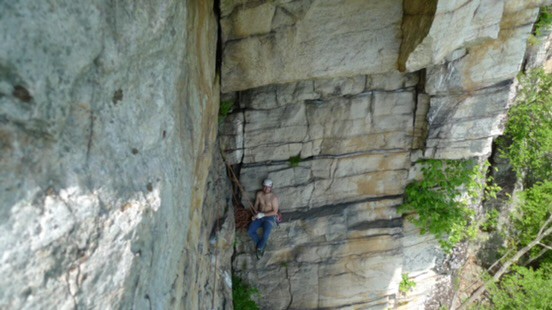
While just a neophyte in the order of organized sports, climbing is not limited by a set of agreed upon rules, and exists beyond the bounds of a game. There are no winners or losers, there is no keeping score. Climbing has always been a personal journey for those driving the culture.
The list of climbing heroes involves stuff of almost myth-like legend: epic races up screaming granite towers between Goliaths of the sport like Royal Robbins and Warren Harden; Jim Bridwell notoriously tripping on LSD while crusading into unexplored routes on of El Capitan; Lynn Hill freeing the Nose for the first time; Chris Sharma sending the hardest route in the United States at 15 and wanting to name the route the Turd Burgler.
Learning climbing culture can be somewhat difficult with the amount of media and information out there. Climbing documentaries have become exceedingly popular commercially, and there are many to choose from on streaming services. I will recommend a few, but feel free to watch them all!
Valley Uprising is a fantastic documentary on climbers who set in stone the ethical and philosophical groundwork that were the origin for modern climbing ethics.
The Dawn Wall and Free Solo are both documentaries that broke climbing into the mainstream like never before. Both are about mind bending ascents that occurred on El Cap, and capture the essence of the sport at its purist.
The Alpinist follows the late Marc-Andre Laclerc. Marc-Andre was an anachronism, and completed the first ever successful solo of Torre Egger in Patagonia.
Most movies and documentaries are fairly contemporary and only stretch back to the late 90’s. One of the most well known OG films is Rampage with Chris Sharma, which is available on youtube. Chris revolutionized the game of difficult climbing, and brought the sport to a whole new level. The documentary covers him and some buddies traveling across the country in an RV to climb some hard boulders.
Rampage – Full Film with Chris Sharma
Reel Rock is a film series that has covered climbers and their efforts to push their limits for the last 24 years. They release most of their films on Redbull’s website for free.
Alex’s Hannold (the dude from Free Solo) has a fantastic podcast called Climbing Gold available on Spotify. Alex does a great job interviewing legends of the sport and telling the untold stories of climbing. I recommend Chapter 4 with John Gill, Cheater Cheater with Alan Watts, Chapter 3 with Chris Sharma, and for some classic Yosemite dirtbag nonsense, listen to his series on Dope Lake.
Find Some Climbing Partners and Get Outside
Meet some people in the gym and at the local crag who challenge you, share your climbing goals, and don’t cut corners when it comes to safety. It is good to surround yourself with people who don’t take themselves too seriously and most importantly are fun to be around. Get out, climb, be safe, and get stoked!
I will leave you with a quote from Ernest Hemingway:
“There are only three sports: mountain climbing, bull fighting, and motor racing. The rest are merely games”

